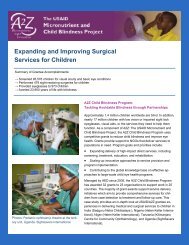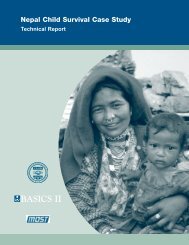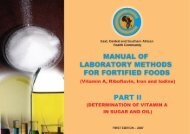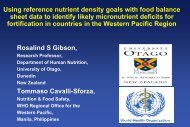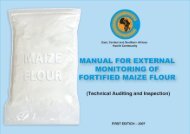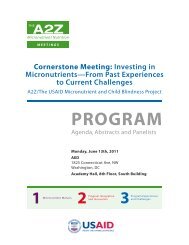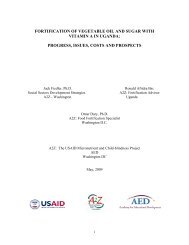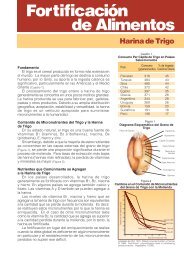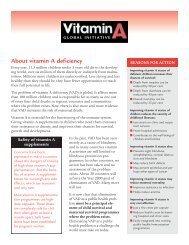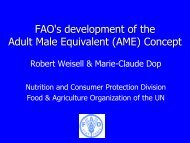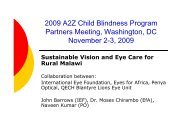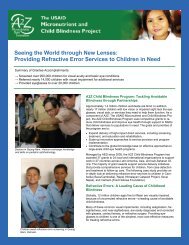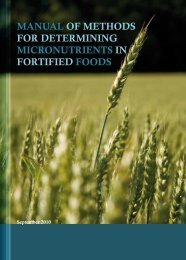Section 5: <strong>Elements</strong> <strong>of</strong> a <strong>National</strong> <strong>Food</strong>-<strong>Fortification</strong> <strong>Program</strong>Section 5: <strong>Elements</strong> <strong>of</strong> a <strong>National</strong> <strong>Food</strong>-<strong>Fortification</strong> <strong>Program</strong><strong>Food</strong> Vehicles and <strong>Fortification</strong> RegimeOilOil is a most suitable food-<strong>for</strong>tification vehicle in <strong>Bangladesh</strong>. Per capita consumption,the structure <strong>of</strong> the processing industry, and low <strong>for</strong>tification costs provide a strongrationale <strong>for</strong> such a conclusion. Analysis <strong>of</strong> the marketing system <strong>for</strong> oil indicates thatmandatory <strong>for</strong>tification would be the optimal option.ConsumptionMustard-seed, soybean, and palm oils are the country’s three major sources <strong>of</strong> edible oil. Sincemustard-seed oil is not suitable <strong>for</strong> <strong>for</strong>tification, the <strong>for</strong>tification program should concentrate onsoybean oil and palm oil. Per capita consumption <strong>of</strong> soybean oil and palm oil is both adequateand rapidly increasing. As detailed in section 4, <strong>for</strong>tified at a minimum vitamin A level <strong>of</strong> 20mg/kg, consumption <strong>of</strong> 13g/day/person <strong>of</strong> oil would supply about 52 percent <strong>of</strong> EAR — an amountexpected to have a significant biological impact. Per capita consumption increased from 10g/dayin 1999-2000 to 14g/day on average between 2000-2001 and 2002-2003, and rose as high as 17g/day in 2000-2002.Oil is consumed in adequate amounts in both rural and urban areas. Although per capita oilconsumption is higher in urban areas than in rural areas, the difference is not substantial. A2000 household income and expenditure survey (<strong>Bangladesh</strong> Bureau <strong>of</strong> Statistics 2001) showsthat per capita oil consumption in rural areas is only slightly lower than 90 percent <strong>of</strong> thenational average (11.24g/day in rural areas and 12.82g/day nationwide).Industry StructureSoybean oil and palm oil, which are imported in an unrefined <strong>for</strong>m, are processed by onlya limited number <strong>of</strong> producers. Of the 15 active oil producers in <strong>Bangladesh</strong>, only 3 have anindividual capacity <strong>of</strong> more than 1000 MT/day, and these producers process 80-90 percent <strong>of</strong>all soybean and palm oil imports. Both the size and limited number <strong>of</strong> producers suggest thatmandatory <strong>for</strong>tification <strong>for</strong> oil would be the most-effective strategy.CostAt Tk 223, or $3.81 per MT, oil has the lowest <strong>for</strong>tification cost among the three commoditiesconsidered — about 20 percent below wheat-flour <strong>for</strong>tification cost and well below sugar<strong>for</strong>tification cost. In addition, total <strong>for</strong>tification costs, including vitamin A, are estimated at 0.46percent <strong>of</strong> retail price <strong>for</strong> oil — 0.43 percent <strong>for</strong> soybean oil, and 0.53 percent <strong>of</strong> palm oil.Wheat FlourWheat flour is a suitable food-<strong>for</strong>tification vehicle in <strong>Bangladesh</strong>. This conclusion is supported bywheat-flour consumption levels and patterns, relatively low <strong>for</strong>tification costs, and the structure14MOST The USAID Micronutrient <strong>Program</strong>
Section 5: <strong>Elements</strong> <strong>of</strong> a <strong>National</strong> <strong>Food</strong>-<strong>Fortification</strong> <strong>Program</strong><strong>of</strong> the milling industry. As detailed below, thewheat-flour <strong>for</strong>tification program should relyon roller mills, not on chakki mills and shouldalso be private-sector driven and voluntary.ConsumptionPer capita wheat-flour consumption isestimated at 43g/day. Although per capitawheat-flour consumption in urban areasis higher than in rural areas, per capitaconsumption in rural areas (about 38g/day)is only 15-20 percent lower than the nationalaverage. As explained in section 4, <strong>for</strong>tification<strong>of</strong> wheat flour would supply an adequateamount <strong>of</strong> about 20 percent <strong>of</strong> the EAR <strong>for</strong>vitamin A, iron, folate, B-12, B-1, B-2, B-6,niacin, and zinc.<strong>Fortification</strong> CostsAs detailed in the previous section,<strong>for</strong>tification costs <strong>for</strong> wheat flour are aboutTk293, or $5 per MT, and represent about 1.6percent <strong>of</strong> retail prices; these figures suggestthat the additional cost <strong>of</strong> <strong>for</strong>tification doesnot appear prohibitive to consumers.A Private-Sector-Driven <strong>Program</strong>The pilot wheat-flour <strong>for</strong>tification programwas implemented in collaboration with theWorld <strong>Food</strong> <strong>Program</strong> (WFP) in support <strong>of</strong>the Vulnerable Group Development (VGD)program. Fortified atta <strong>for</strong> the VGD programis produced in special chakki mills that havebeen constructed with equipment (includingmicronutrient feeders) imported fromDenmark. These mills are operated by NGOs,under the close supervision <strong>of</strong> USAID andWFP. While this arrangement may be suitable<strong>for</strong> the limited production envisaged under theongoing pilot activity, no mechanism is nowin place that will allow production to expandbeyond the VGD program or to continuebeyond WFP’s current programming cycle.There are two reasons <strong>for</strong> concluding thatthe current approach <strong>of</strong> producing <strong>for</strong>tifiedflour in small chakki mills operated byNGOs is neither institutionally viable noreconomically sustainable under a larger-scaleprogram. First, if the <strong>for</strong>tification <strong>of</strong> wheatflour is to expand on a sustainable basis, itmust be embedded in the prevailing flourproductionand -marketing system. Passed onto consumers, the costs <strong>of</strong> <strong>for</strong>tification willbe reflected in somewhat higher flour prices.Since the flour market in <strong>Bangladesh</strong> is drivenby a vibrant and highly competitive privatesector, any flour-<strong>for</strong>tification program shouldbuild on this private-sector-based structure.Second, due to the small size <strong>of</strong> thechakki mills, their large number, and theirdistribution in remote and scattered locationsin rural areas, they are difficult to regulate.It should be added that less-refined chakkimillflour contains larger quantities <strong>of</strong> naturalvitamins and minerals than does the refinedroller-mill maida.A Roller-Mill Driven Manufacturing MethodMilling capacity is a critical factor indetermining the ease and method <strong>of</strong><strong>for</strong>tification. Evidence from other countriessuggests <strong>for</strong>tification at medium (25–150 MT/day) and large mills (>150 MT/day) to bemost appropriate, whereas the feasibility andeffectiveness <strong>of</strong> <strong>for</strong>tification at smaller stone orhammer mills has yet to be established. Largemills invariably have more-modern equipmentand a higher technical capacity to integrate the<strong>for</strong>tification technology. Larger mills can alsomore easily amortize start-up costs and takeadvantage <strong>of</strong> various economies <strong>of</strong> scale inproduction and marketing. 6Chakki mills in <strong>Bangladesh</strong> typically havethe capacity to grind only a few tons <strong>of</strong> grainper day, whereas the capacity <strong>of</strong> roller millsranges from 20 to 150 MT/day. The fact thatmany <strong>of</strong> the roller mills are already usingplastic packaging and engage in advertisingbased on product quality also makes rollermills a logical place to initiate commercial<strong>for</strong>tification.6 See previous footnote<strong>Elements</strong> <strong>of</strong> a <strong>National</strong> <strong>Food</strong>-<strong>for</strong>tification <strong>Program</strong> <strong>for</strong> <strong>Bangladesh</strong>15



